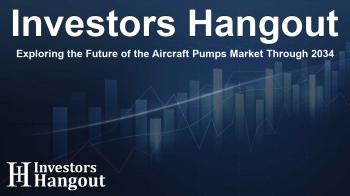Exploring the Future of the Aircraft Pumps Market Through 2034

Growth Projections for the Aircraft Pumps Market
The aircraft pumps market is on a promising trajectory, with projections indicating a compound annual growth rate (CAGR) of 3.4% from 2024 to 2034. By the end of this period, the market is expected to reach a significant size of US$8.0 billion, marking a substantial opportunity for companies involved in this sector.
Comprehensive Overview of Market Segmentation
As outlined in a recent analysis, the segmentation of the aircraft pumps market is essential for understanding the driving factors behind its growth. The market comprises various segments, including different types of aircraft, applications, pump types, and geographical regions.
Aircraft Types and Their Influence
The aircraft pumps market is primarily divided into several categories based on aircraft type: commercial aircraft, military aircraft, regional aircraft, business jets, and helicopters. Notably, commercial aircraft are expected to continue their dominance in this market, largely due to their extensive operations and the ongoing demand for maintenance and upgrades.
With the rise of global air travel and the need for modernizing fleets, commercial aircraft's operational scale drives the demand for various pump systems crucial for fuel delivery, hydraulic control, lubrication, and cooling mechanisms.
Application Types That Are Driving Demand
In terms of application types, the market is categorized into hydraulic systems, engine applications, gearbox functionalities, and emergency systems. Hydraulic systems, in particular, account for a substantial portion of the market; their ability to facilitate critical aircraft operations assures their ongoing relevance.
Additionally, the emergence of gearbox applications is noteworthy, evolving as a key category driven by advanced engine technology. As the aviation industry leans into innovations like fuel-efficient engines and electric propulsion systems, the need for specialized pumps will grow, solidifying the gearbox segment's importance.
Regional Insights: The Largest Players in the Market
The North American region is predicted to maintain its status as the largest market for aircraft pumps. This is primarily due to a robust aerospace industry characterized by leading aircraft manufacturers and significant military aviation advancements.
In contrast, the Asia-Pacific region is set to experience the most rapid growth, fueled by a surge in air traffic, expansion of airline fleets, and increased investments in defense sectors. Countries such as China and India are enhancing their aircraft production capacities, leading to a burgeoning demand for pump systems.
Market Drivers and Trends
Several factors are propelling growth in the aircraft pumps market. The rising demand for international air travel and fleet expansion fuels the need for advanced, lightweight, and energy-efficient pumping solutions.
Innovation in aircraft technology, especially in military aviation, is pushing manufacturers to create pumps that can meet higher performance standards and adapt to complex mission requirements. This trend illustrates a pivotal shift towards modernization and efficiency in the aerospace sector.
Top Contenders in the Aircraft Pumps Market
Key players shaping the aircraft pumps market landscape include major firms such as Eaton Corporation, Parker Hannifin, and Honeywell International, among others. Their continued investment in research and development allows them to push the envelope in terms of technology and operational efficiency within the sector.
Through innovative products and strategic partnerships, these companies are well-positioned to cater to the evolving needs of the aerospace industry as it transitions toward more environmentally sustainable practices.
Conclusion
The aircraft pumps market presents a wealth of opportunities for stakeholders and businesses involved in related technologies as it moves toward a projected value of US$8.0 billion by 2034. With profound insights into market trends, key drivers, and major players, industry participants can make informed business decisions that align with the anticipated growth trajectory.
Frequently Asked Questions
What is the projected market size of aircraft pumps by 2034?
The aircraft pumps market is expected to reach US$8.0 billion by 2034.
Which aircraft type is projected to dominate the aircraft pumps market?
Commercial aircraft are expected to remain the dominant type in the aircraft pumps market.
What are the primary application areas for aircraft pumps?
The main application types include hydraulic systems, engine systems, and gearbox applications.
What region is expected to lead the aircraft pumps market?
North America is projected to remain the largest market for aircraft pumps due to its strong aerospace industry.
Who are the top players in the aircraft pumps market?
Key players include Eaton Corporation, Parker Hannifin, Honeywell International, and more.
About The Author
Contact Thomas Cooper privately here. Or send an email with ATTN: Thomas Cooper as the subject to contact@investorshangout.com.
About Investors Hangout
Investors Hangout is a leading online stock forum for financial discussion and learning, offering a wide range of free tools and resources. It draws in traders of all levels, who exchange market knowledge, investigate trading tactics, and keep an eye on industry developments in real time. Featuring financial articles, stock message boards, quotes, charts, company profiles, and live news updates. Through cooperative learning and a wealth of informational resources, it helps users from novices creating their first portfolios to experts honing their techniques. Join Investors Hangout today: https://investorshangout.com/
The content of this article is based on factual, publicly available information and does not represent legal, financial, or investment advice. Investors Hangout does not offer financial advice, and the author is not a licensed financial advisor. Consult a qualified advisor before making any financial or investment decisions based on this article. This article should not be considered advice to purchase, sell, or hold any securities or other investments. If any of the material provided here is inaccurate, please contact us for corrections.

